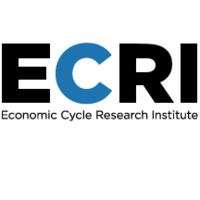 | ||
The Economic Cycle Research Institute (ECRI) based in New York, is an independent institute formed in 1996 by Geoffrey H. Moore, Anirvan Banerji and Lakshman Achuthan.
Contents
Purpose
ECRI’s mission to preserve and advance the tradition of business cycle research established by Dr. Moore at the National Bureau of Economic Research (NBER) and Center for International Business Cycle Research (CIBCR).
International Business Cycle Chronologies
Before there was a Business Cycle Dating Committee to determine U.S. business cycle dates, Moore determined them on the NBER's behalf from 1949 to 1978, and then served as the committee's senior member until he died in 2000. Using the same approach, ECRI has long determined recession start and end dates for over 20 other countries that are widely accepted by academics and major central banks as the definitive international business cycle chronologies.
History
ECRI today represents a third generation of cycle research, building on the work of ECRI's co-founder, Geoffrey H. Moore, and his mentors, Wesley C. Mitchell and Arthur F. Burns.
1920, Wesley C. Mitchell and his colleagues established the National Bureau of Economic Research (NBER), with a primary objective of investigating business cycles.
1927, Mitchell laid down the standard definition of business cycles: "Business cycles are a type of fluctuation found in the aggregate economic activity of nations that organize their work mainly in business enterprises: a cycle consists of expansions occurring at about the same time in many economic activities, followed by similarly general recessions, contractions, and revivals which merge into the expansion phase of the next cycle; this sequence of changes is recurrent but not periodic; in duration business cycles vary from more than one year to ten or twelve years; they are not divisible into shorter cycles of similar character with amplitudes approximating their own."
1929, with the start of the Great Depression, business cycle researchers had a practical emergency on their hands. With the economy back in recession, in the summer of 1937, U.S. Treasury Secretary Henry Morgenthau Jr. requested Mitchell "to draw up a list of statistical series that would best indicate when the recession would come to an end."
1938, Mitchell and Arthur F. Burns identified the first leading indicators of revival.
Also in 1938, Geoffrey H. Moore joined Mitchell and Burns at the NBER.
1946, Moore taught Alan Greenspan, who served as Chairman of the Federal Reserve of the United States from 1987 to 2006, Statistics 1 at New York University.
1950, Moore developed the first-ever leading indicators of cyclical revival and recession.
1958 to 1967, Moore, working with Julius Shiskin, developed the original composite index method, and the composite indexes of leading, coincident, and lagging indicators of the U.S. economy.
1968, Moore gave over to the U.S. government the original composite leading, coincident and lagging indexes, which the Commerce Department adopted (and published regularly in Business Cycle Developments (BCD), soon renamed Business Conditions Digest), with the Index of Leading Economic Indicators (LEI) becoming its main forecasting gauge.
1969, Moore was appointed U.S. Commissioner of Labor Statistics, and took a four-year leave from the NBER. While Commissioner, he started the collection of additional statistics, including the Employment Cost Index.
1973, Moore and Philip A. Klein began developing international leading indexes.
1979, having retired from the NBER, Moore established the Center for International Business Cycle Research (CIBCR) at Rutgers University, moving it four years later to Columbia University.
February 1994, following a surprise rate hike, Chairman Greenspan testifies in Congress that "anything that Geoffrey Moore does I follow closely," to which a Congressman replies, "No kidding."
1995, Moore received the American Economic Association's Distinguished Fellow Award.
1996, Moore, with his protégés, Lakshman Achuthan and Anirvan Banerji, established the independent Economic Cycle Research Institute (ECRI), which virtually all of their CIBCR colleagues then joined is join.
ECRI's Approach
Many economists claim that recessions cannot be predicted. This is correct in the sense that standard forecasting models used by economists cannot accurately predict a recession: as a 63-country study of economists' predictions conducted by the International Monetary Fund concluded, their "record of failure to predict recessions is virtually unblemished."
However, this does not mean that predicting recessions is impossible. As The Economist noted in 2005, "ECRI is perhaps the only organisation to give advance warning of each of the past three recessions; just as impressive, it has never issued a false alarm."
Publicly Available Data
The U.S. Weekly Leading Index (WLI) of economic activity.
The U.S. Coincident Index (USCI) is a broad measure of current economic activity.
International business cycle chronologies for 21 economies.
Recession and Recovery Calls
2001 Recession Call
In March 2001 ECRI made a U.S. recession call and in April 2001 ECRI's Achuthan told The Wall Street Journal that "the economy has passed the point of no return, beyond which it is not possible to shift away from the recession track."
2007 - 2009 Recession and Recovery Calls
In March 2008 “the Economic Cycle Research Institute, a firm that focuses on identifying peaks and troughs in the business cycle, made its official call on Friday, stating that the U.S. economy had "unambiguously" entered a recession.”
In April 2009 ECRI said “The longest U.S. recession in more than a half-century will probably end before the summer is out.”
2011-12 Recession Forecast
In September 2011 ECRI forecast a U.S. recession that never happened. Growth did slow sharply and was “about as weak as it could be without falling into recession.” ECRI “had predicted that the final six months of 2012 would register contraction. The first estimate of GDP growth came in at 1 ½% (that is, at an annual rate of 1 ½%). The fifth revision to that initial estimate, unveiled in July, pushed down the measured rate of growth to a quarter of 1%, about as close to shrinkage as a positive growth figure can be."
